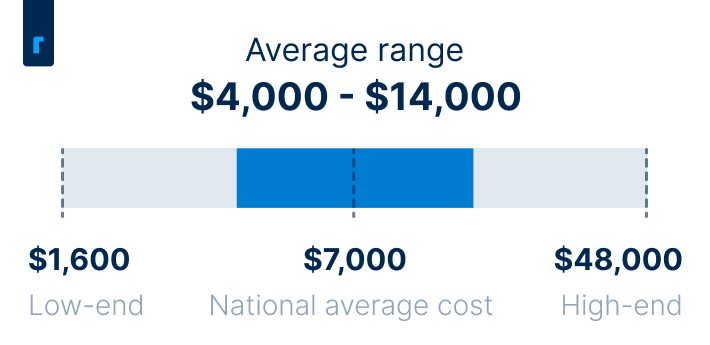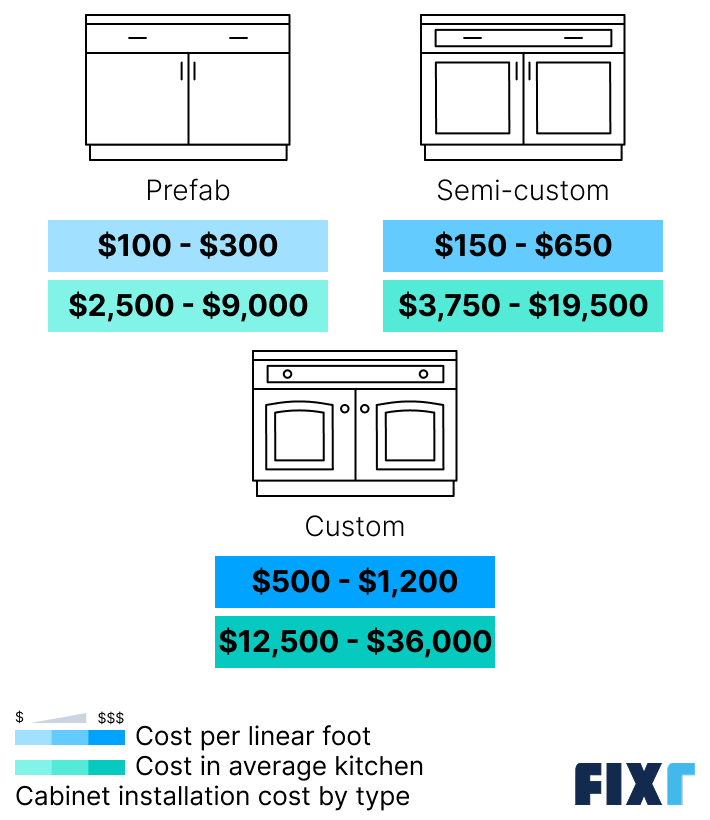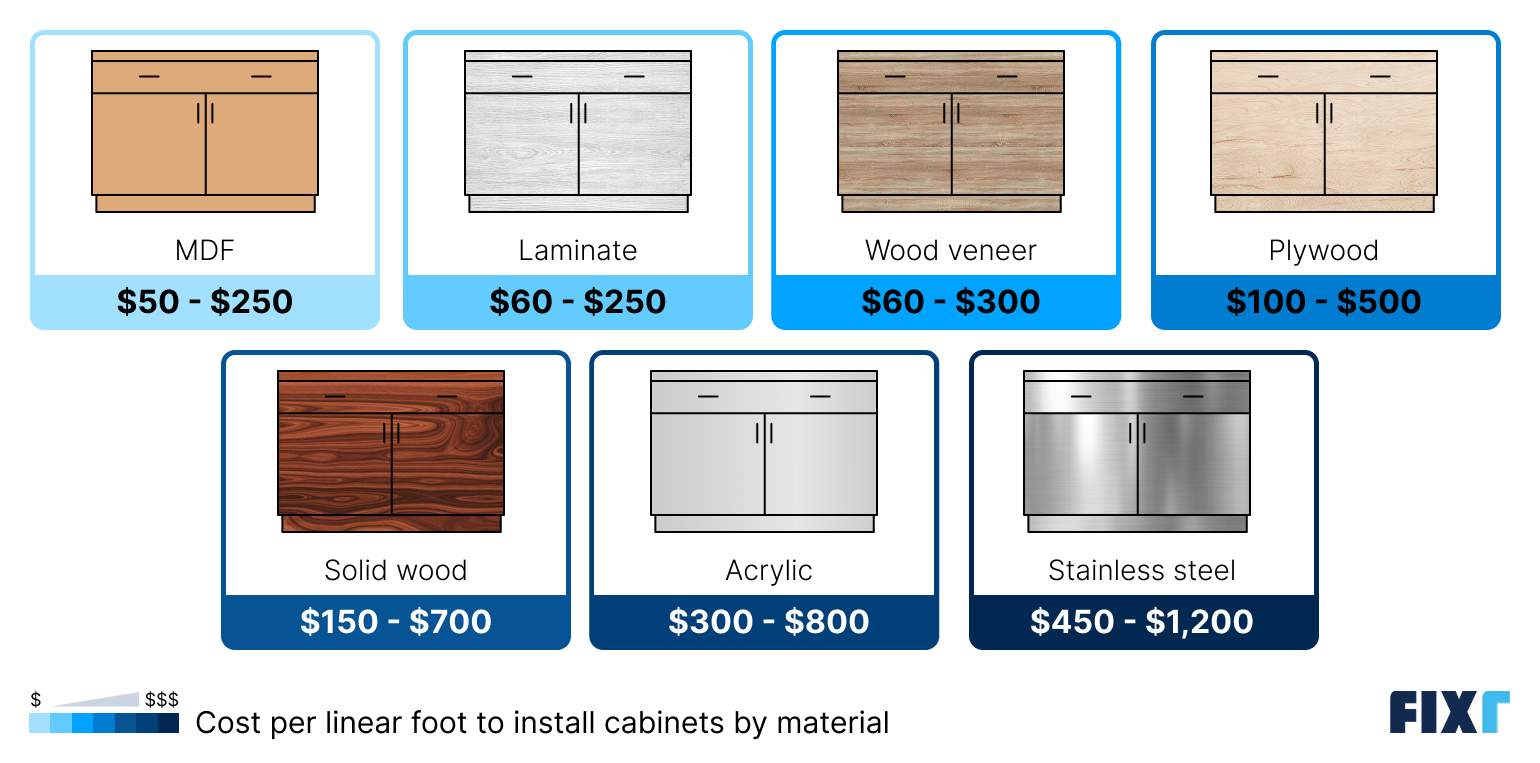Updated: November 7, 2025
Written by Dan Simms
Nieves is a home remodeling editor at Fixr.com with special interest in landscaping, pest control, painting, installation, and repair projects. She brings her work ethic, creativity, and love for teamwork into everything she does, including working with writers and designers at Fixr.com to develop useful and comprehensive guides for homeowners.
Learn moreReviewed by Nieves Martinez
New kitchen cabinets can instantly give your kitchen a major facelift, and since the kitchen is one of the things buyers focus on most, the project can drastically improve your home value. Even if you’re not selling your home anytime soon, replacing cabinets can improve your own enjoyment of one of the most frequented rooms in your house.
The national average cost to install kitchen cabinets is $7,000, and most homeowners pay somewhere between $4,000 and $14,000. Your costs will depend mostly on the size of your kitchen and the linear feet of cabinets you need replaced, as well as whether you choose stock, semi-custom, or custom cabinets.
Average Cost of Kitchen Cabinets


Kitchen Cabinets Cost Factors
There are a few key cost factors to consider to determine what your cabinet replacement project will cost.
Kitchen Cabinet Installation Cost by Type
The most crucial factor influencing your total is the type of kitchen cabinets you choose. There are three options: stock, semi-custom, and custom. These range from $100 per linear foot to more than ten times that at $1,200 per linear foot.


Type | Cost per Linear Foot | Cost in an Average Kitchen |
Stock | $100 – $300 | $2,500 – $9,000 |
Semi-custom | $150 – $650 | $3,750 – $19,500 |
Custom | $500 – $1,200 | $12,500 – $36,000 |
Stock Kitchen Cabinets
These are the most affordable option, costing between $100 to $300 per linear foot. These are pre-made and offer no customization options, but they are readily available and a practical choice for most modern homes.
Cost of Semi-Custom Cabinets
Semi-custom cabinets are the most popular option because they balance upfront cost and customizability. The average cost of new kitchen cabinets that are semi-custom is between $150 to $650 per linear foot. While more expensive than stock, they are made to suit your specific kitchen, though this does mean a longer installation time.
Custom
Fully custom cabinets provide unlimited flexibility for size, layout, material, and colors, but they can cost more than ten times as much as stock cabinets per linear foot. Most homeowners pay between $500 and $1,230 per linear foot for custom cabinets. They also take the longest to build (6-12 weeks) but are ideal for those wanting premium materials and a perfect fit.
Cost of New Kitchen Cabinets By Material
The cabinet material you choose will also affect your material costs and your installation costs. Most modern cabinets are made of plywood boxes with solid wood doors and drawers, as this provides a balance between cost, quality, and durability. The cost of solid wood kitchen cabinets with no plywood is significantly higher due to both the more expensive material and the higher labor costs to move the heavier cabinets into place.
Stainless steel kitchen cabinets cost more than any other material, but they’re also more resistant to warping and water damage than wood. Medium-density fiberboard (MDF) is one of the most affordable materials, but it’s the most susceptible to water damage.


Cabinet Material | Average Cost per Linear Foot |
MDF | $50 – $250 |
Laminate | $60 – $250 |
Wood veneer | $60 – $300 |
Plywood | $100 – $500 |
Solid wood | $150 – $700 |
Acrylic | $300 – $800 |
Stainless steel | $450 – $1,200 |
Kitchen Size
The size of your kitchen is another important factor to consider that can swing your kitchen cabinet installation costs well above or below the national average. Most cabinet installers will base your total costs on the linear feet of kitchen cabinetry you need.
The average kitchen is between 150 and 250 square feet and needs between 25 and 30 linear feet of cabinets. The cost of kitchen cabinets for a 10x12 kitchen will be lower, and the cost for an oversized or luxury kitchen can be much higher.
The table below presents an average cost estimate, calculated using a mid-range cost per linear foot.
Kitchen Size (Feet) | Avg. Cabinetry Needed (Lin. Ft.) | Average Cost |
10 x 10 | 16 | $2,400 – $10,400 |
10 x 12 | 20 | $3,000 – $13,500 |
12 x 12 | 25 | $3,750 – $16,250 |
12 x 15 | 30 | $4,500 – $19,500 |
15 x 20 | 40 | $6,000 – $26,500 |
Labor Cost to Install Kitchen Cabinets
In most cases, the labor cost for kitchen cabinet installation will account for between 30% and 50% of the total.
Labor costs can vary based on many factors. First, some installers charge flat rates based on cabinet size, which usually fall around $50 to $200 per linear foot. Others charge flat rates for entire projects, and some charge hourly rates, which average between $40 and $100 per hour.
Your labor costs can also climb higher if you have anything that complicates the installation, like a unique kitchen layout or a kitchen located up numerous flights of stairs that would require more labor to move your cabinets into position.
Other Factors That Affect Kitchen Cabinets Cost
When budgeting for new kitchen cabinets, remember that several smaller factors can also impact your final price.
Removal and Disposal of Old Cabinets
Unless you’re building new construction or adding a kitchen to your home, you should consider the cost to remove and haul away your existing cabinets. Expect to pay between $350 and $1,000 on average to remove and haul them away, depending on your kitchen size and cabinet type.
Type of Installation
There are three types of cabinet installations you can choose from.
Framed cabinets: With framed cabinets, your cabinet box will be visible around doors and drawers, and the doors and drawers will visibly sit in front of the frame. They are traditional and budget-friendly.
Frameless cabinets: Frameless cabinets are more modern. The cabinet doors cover the entire front of the box, creating a more cohesive look. Expect to pay between 20% and 50% more.
Inset cabinets: Inset cabinets have doors and drawer fronts that sit flush with the front of the cabinet box. This creates a seamless and modern look, but since inset cabinets require more precise manufacturing and special hardware for cabinet door operation, they’re also the most expensive.
Kitchen Layout and Complexity
The installation process will be more challenging if you have an unusual layout or angled walls, and stock cabinets are less likely to work in unique kitchen designs, which could mean you have to pay more to upgrade to semi-custom or custom cabinets.
Hardware and Accessories
In addition to the actual cabinet boxes, doors, and drawers, you’ll need hinges, drawer slides, pulls, and handles. Upgrading to soft-close doors or premium finishes adds to the total.
Plumbing and Electrical Work
Most homeowners replace their kitchen cabinets as part of a larger kitchen remodel. If you’re planning on changing your kitchen layout, adding appliances, or adding new GFCI outlets, switches, or lighting fixtures, be sure to budget for those upgrades separately. These changes can range from hundreds to thousands of dollars.
Add-ons
You should also consider any other upgrades or changes that often accompany a kitchen remodel, such as adding new countertops and a backsplash, which can increase your total cost by about $3,000 and $1,000, respectively.. Other common upgrades include kitchen flooring replacement, new lighting fixtures, upgraded plumbing fixtures, and appliance packages. You can also consider adding new trim to your kitchen or crown molding to your new cabinets.
DIY vs. Hiring a Professional
DIYing kitchen cabinet installation can save you on labor costs. However, while it might seem like a good way to save on your kitchen renovation costs, this is one job that’s best left to the pros. Installing kitchen cabinets requires experience, precision, and the right tools. It’s easy to make mistakes when measuring or leveling, which can lead to a poor appearance and even cracked countertops.
Hiring a licensed professional ensures the job is done properly, the cabinets are aligned and secure, and any manufacturer warranties remain intact. Although professional installation adds to the overall cost, it reduces the risk of errors, damage, and the need for future repairs. Ultimately, while professional installation is more expensive, it could end up saving you time, stress, and money.
Ways to Save Money on Cabinet Installation
Saving money on kitchen cabinet installation doesn’t have to mean cutting corners. By planning carefully, choosing the right materials, and making smart decisions, homeowners can reduce costs without sacrificing quality or durability.
Choose stock cabinets: Pre-made cabinets are the most affordable compared with semi-custom or custom units.
Choose affordable materials: Cabinet prices vary greatly by material. Opting for options like laminate can be much more budget-friendly than solid wood, but make sure you choose based on durability and not just upfront cost.
Do the demolition yourself: While DIYing the kitchen cabinet installation usually isn’t a good idea, you can save on labor costs by handling the removal and disposal of your old cabinets. This can be a straightforward DIY task that reduces the total project cost by up to $1,000.
Get multiple quotes: Get estimates from at least three different contractors to compare prices, timelines, and services. This allows you to find the best value for your project and rule out providers that come in unusually high or low.
Keep the layout simple: Sometimes, layout changes during your kitchen remodel are necessary. If possible, though, avoid moving plumbing or electrical fixtures, as these can drastically increase installation costs.
Alternatives to Replacing Kitchen Cabinets
If you're looking to update your kitchen's appearance without the expense of a full cabinet replacement, there are a few alternatives that can bring costs down but still provide a fresh look.
Cabinet painting: Sanding and repainting your cabinets is one of the most popular and cost-effective ways to revitalize your kitchen without a complete replacement. A new coat of paint can completely change the look and feel of your kitchen. Painting kitchen cabinets typically costs between $2,500 and $6,500.
Cabinet refinishing: Refinishing your cabinets involves sanding down the existing finish and applying a new stain or clear coat. This is an excellent option for restoring the natural beauty of solid wood cabinets that may have faded or been damaged over time. Costs typically range from $2,000 to $4,500 for a standard kitchen.
Cabinet refacing: This involves replacing the cabinet doors and drawer fronts with new ones, while keeping and refinishing the existing cabinet boxes. Refacing offers the look of a brand-new kitchen at a lower cost than a full replacement. On average, cabinet refacing costs between $3,000 and $13,500.
Hardware update: For a simple and inexpensive kitchen update, consider leaving your cabinets as they are and swapping out old knobs, pulls, and handles. New hardware can give your cabinets a modern feel and is an easy DIY project, usually costing $50 to $500, depending on the number of pieces and style chosen.
FAQs
The cost of cabinets for a standard 12x12 kitchen typically ranges from $3,750 to $16,250. The total cost can vary significantly based on the type of cabinets chosen.
The installation process for kitchen cabinets for most mid-size kitchens takes 1 to 3 days, depending on cabinet type and kitchen complexity. However, the process could take up to a week if you have a complex kitchen layout and need other upgrades done at the same time, like countertop or backsplash installation.
Handymen may handle simple cabinet installations and can usually get the work done for less, but licensed professionals ensure cabinets are level and secure, and they make sure that your manufacturer warranties remain valid. Professional kitchen remodeling companies or carpenters are better options if you purchase semi-custom or custom cabinets.
Yes, replacing old or damaged cabinets is usually worthwhile, as it can improve functionality, update the kitchen’s style, and increase home value, especially if repairs aren’t sufficient.
